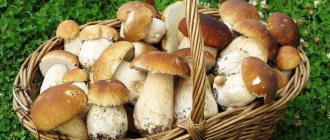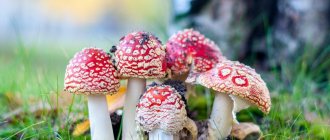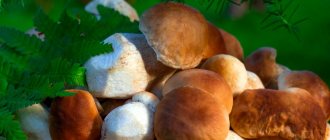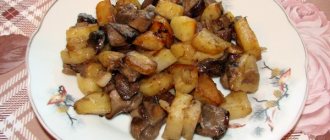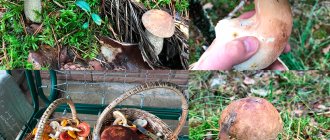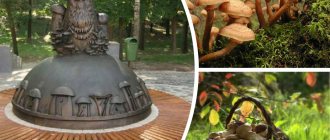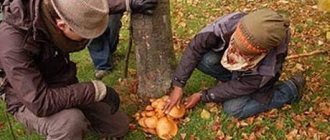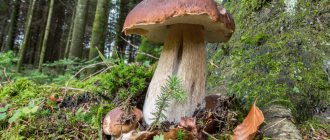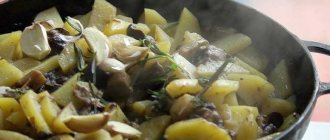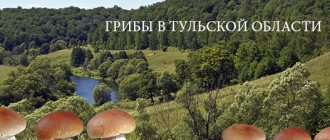Mushrooms in the Leningrad region 2022 is a topic that is raised annually by all lovers of quiet hunting. In order to collect full buckets of tasty trophies, you don’t need to travel far; in fact, in the Leningrad region there are hot spots that, depending on the season, are rich in certain types of mushrooms.
Mushroom places in the Leningrad region now 2022
The first thing that needs to be said is that collecting tasty trophies is becoming more dangerous every year due to the construction of new roads, factories and the high level of pollution in rivers and other types of reservoirs, near which many mushrooms could previously be found. The latter tend to absorb toxins, accumulate them, turning into food hazardous to health. When going on a quiet hunt in the Leningrad region, focus on hot spots that have been tested by experienced mushroom pickers:
- Priozersky district, within which Sosnovy Bor is located. You can get here by driving along the Vyborg Highway.
- The village of Sosnovo, where you go by train from St. Petersburg, Finsky Station. Full buckets of trophies are guaranteed in Sosnovy Massif.
- The village of Kirillovskoye, where there are many clearings in the forest area. You can get here by train or by car if you travel through Scandinavia.
- Sosnovy Bor near Vsevolozhsk district. You will have to drive approximately 118 kilometers from this area; you need to navigate using a map or navigator.
- Forests of the Luga region, which is located next to the lake, to the south of it.
- The village of Zakhodsky, where trains go. The number of edible mushrooms here is impressive.
Bulbous honey fungus or dark honey fungus
It is necessary to know what edible honey mushrooms look like, since most of the presented species have false poisonous counterparts. Due to its characteristics, summer honey fungus has received other names of both Latin and Russian origin. The type of mushroom in question has the following scientific names:
- Agaricus mutabilis Schaeff;
- Pholiota mutabilis (Schaeff.);
- Dryophila mutabilis (Schaeff.);
- Galerina mutabilis (Schaeff.).
Dark mushrooms.
In the Russian language, the following variants of names for this type of honey mushroom have taken root.
- Talker. The etymology of this word can be found in V. I. Dahl’s dictionary, where it is indicated that part of the word “talk” can mean a blister or bubble. This is explained by the shape of the cap in its central part, and looks like a tubercle or blister.
- Lime. This name is associated with the location of the summer honey fungus. You can often find this type of mushroom on damp linden wood.
- Volatile. This name is associated with the hygrophanous property of the honey fungus. In dry weather, the cap turns pale, losing its specific characteristics, so it is often confused with other mushrooms. With sufficient humidity, the color of the cap becomes two-tone: in young ones it is yellow-brown, in old ones it is brown-orange.
| Group: | Lamellar |
| Records: | Yellowish-white, yellow-brown |
| Color: | Yellow color with various shades - brown, honey, ocher |
| Peculiarities: | Ring on the leg |
| Department: | Basidiomycota (Basidiomycetes) |
| Sub-department: | Agaricomycotina (Agaricomycetes) |
| Class: | Agaricomycetes (Agaricomycetes) |
| Subclass: | Agaricomycetidae (Agaricomycetes) |
| Order: | Agaricales (Agaric or Lamellar) |
| Family: | Physalacriaceae |
| Genus: | Armillaria (Honey fungus) |
| View: | Armillaria ostoyae (Dark honey fungus) |
People can hear another unusual name for the summer honey fungus - “Varushka”. There is an opinion that this name comes from the word “cook”. This confirms the fact that the mushroom in question should be consumed boiled. A feature of this species is drying on the vine. The mushroom never rots. Among the productive ones you can find small, darkened ones. You can recognize the meadow honey fungus by the characteristic tubercle in the center of the cap.
Dark mushrooms.
These mushrooms do not have a cover, which is why they are often confused with toadstools. They can be distinguished by their rare cream or light brown plates and a pleasant, slightly nutty smell. This mushroom can be found along ditches, on roadsides, and in clearings of deciduous forests. It grows in several layers. The first appears in May, the last in October.
Honey fungus is a rather dangerous forest parasite. Where large accumulations of this fungus are noticed, trees begin to die for an apparently incomprehensible reason. In fact, honey mushrooms are to blame for this, as they are able to penetrate the thickness of the wood with hyphae and deprive the tree of nutrients.
Mushroom pickers only collect the caps; the stems are too hard. Poisonous collibia, masquerading as honey fungus, can be recognized by its tubular stem, unpleasant odor, and white densely spaced plates; they float onto the stump of the mushroom. Another dangerous twin is the talker. It has a perfectly even cap, much lighter than its edible counterpart. The pulp is mealy, practically odorless.
Where to look?
It is not necessary to rely only on the above mushroom places. General guidelines can also be taken as a basis for quiet hunting in the Leningrad region. The majority of edible mushrooms here are located in mixed forests or pine forests. It is better to go there with the beginning of the mushroom season, in the fall. Of course, you can collect trophies in the spring, as well as in the summer, but you need to prepare for the fact that there will be less fruit than usual even in green areas.
Those mushroom pickers who are afraid to go in search of new mushroom glades without exact coordinates can protect themselves to the maximum by going on a quiet hunt within the Zerkalny area, where you can find the purest forest areas. You can find out more about this place online thanks to forums and mushroom picking clubs.
Description of the appearance of the mushroom and its characteristics
Winter honey fungus belongs to the edible mushrooms of the family Oryadovaceae or Negniuchkovye. In literary sources it is called Flammulina or Collibia velvety-footed, Enokitake or Winter mushroom. Fruits in colonies, found in fused form.
The cap is round and convex, but becomes flat with age. The surface is flat, smooth, with a large accumulation of mucus, which does not disappear even after heat treatment. The diameter ranges from 2 to 8-12 cm. The color palette varies from golden-honey to orange-brown, a light shade and transparent stripes are present at the edges, while the leg is painted in a darker color.
The leg is tubular in shape, resembling a cylinder. It has a dense, velvety structure. Height is from 2 to 8 cm, diameter is 0.3-1 cm. The upper part has a yellowish tone, the lower part is more saturated, most often reddish-brown.
The pulp is juicy, colored white or pale yellow, tougher at the lower edge of the stem and tender in the cap area. The smell and taste are pleasant, but mild.
The plates are adherent to the stem, sparse, sometimes shortened. Young fruiting bodies have a cream or light yellow color, but over time it changes to a darker color. White spore powder. The shape of the spores ranges from cylindrical to ellipsoid.
Winter honey fungus is an edible mushroom that contains many useful substances:
- amino acids;
- protein;
- zinc;
- potassium;
- iodine;
- antioxidants.
It is used in cooking, pharmacology, cosmetology and medicine. Scientists have found that the substance flammulin, which is found in large quantities in winter honey fungus, is effective for the prevention of sarcoma and the treatment of benign tumors - fibroids, fibroids, adenomas, mastopathy, as well as thrombophlebitis.
When consuming winter mushrooms, the development of neoplasms is inhibited, the immune system is strengthened, cholesterol levels are reduced and liver cells are restored. But there are a number of contraindications:
- diseases of the gastrointestinal tract;
- allergy;
- pregnancy and lactation period.
Have the mushrooms gone, what they write on the forum?
At the forum of mushroom pickers in the Leningrad region, they discuss the main types of mushrooms that have recently been bearing fruit well in this region. Experienced lovers of quiet hunting indicate that those who go for:
- Honey mushrooms;
- Oyster mushrooms;
- Boletuses;
- Veselki;
- Morels;
- White mushrooms;
- Butter;
- Chanterelles.
It is more difficult to find Truffles, however, such mushrooms germinate in the Leningrad region. The main thing is not to confuse edible types of mushrooms with their counterparts.
The Leningrad region is “rich” in Yellowing Champignon, False Honey Mushrooms, Fly Agarics, Toadstools, Strings. All types of mushrooms are hallucinogenic and poisonous.
Types of mushrooms
The honey mushroom group is one of the most complex in its composition, as it combines mushrooms that belong to different genera and families.
As a rule, mushroom pickers collect the most famous species, which are not only edible, but also excellent for pickling and freezing. In addition, collection can begin in early spring, when other types of mushrooms have not yet matured.
Most often, mushroom pickers pay attention to species that grow seasonally (winter, summer, autumn). Let's consider their characteristic features
More information about the main types is presented in the video.
Description
The most recognizable are winter, spring and summer. Since there are many types of them, we will provide a description and photo of the main varieties.
You can recognize the winter variety by its characteristic features:
- A smooth honey-colored cap, which has a hemispherical shape in young mushrooms and spread out in mature ones;
- Cream color of the plates;
- The pulp has a pleasant taste;
- Absence of scales and rings on the leg characteristic of other species.
Summer ones are easy to recognize in wet weather by their sticky cap, which in conditions of high humidity takes on a two-color color (light brown center and dark edges).
In dry weather, you should pay attention to other characteristic features:
- Small scales and a ring on a thin stalk;
- The plates are creamy brown;
- A layer of brown spore powder that spills out of old mushrooms onto the plants of the lower tier.
To distinguish young and mature specimens, you need to pay attention to the shape of the cap. In a young specimen it is small in size and convex in shape, covered with a film in its lower part
The older the mushroom becomes, the flatter the cap becomes, and the film turns into a ring on the stem.
Spring ones, on the contrary, in wet weather have a cap that is dark in the center and light along the edge. Just like winter ones, they lack scales and a ring on the leg, and the spore powder is creamy white.
Autumn ones are radically different from all previous ones and differ in the following characteristic features:
- A mature mushroom has a fairly large cap (10-15 cm in diameter)
- The color of the cap is gray-yellow or yellow-brown.
- A clearly defined ring on the stem of the mushroom.
- The presence of a large number of small scales on the surface of the cap and stem in young specimens.
- White color of spore powder.
- The plates change color from white-yellow in young specimens to creamy brown in mature specimens.
- The pulp of the mushroom has a pleasant smell and taste.
Characteristic
The winter species is interesting because it begins to bear fruit at the end of September and during warm winters it can even grow under snow (Figure 2). As a rule, it grows on dead wood or on the stumps of deciduous trees. And although in the scientific literature it is classified as a conditionally edible mushroom, winter mushroom is considered one of the most delicious among other species. In addition, this species is excellent for growing at home.
From April until the end of October, summer varieties can be found on stumps and rotten wood of deciduous trees. In mountainous areas, these fungi also settle on coniferous plants.
Spring mushrooms do not have any special nutritional value, so they are used as an addition to other mushrooms when preparing dishes from them. They can grow both on rotten wood and on the forest floor.
Autumn species can be found in damp forests around the stumps of deciduous trees. Since this type of fungus is a parasite, it quite often settles on living trees, bushes and even herbaceous plants. At night, stumps, entangled in a thin network of mycelium, glow in the dark. As for the taste of this type of mushroom, there is no clear opinion on this matter.
Map photo
Mushrooms in the Leningrad region 2022 go looking and, focusing on the general map, where the following are highlighted:
- Priozersky district;
- Sosnovo with its mixed forests;
- Losevo, where not far from Vuoksa moss mushrooms, a lot of boletus mushrooms, a lot of porcini mushrooms and oil caps sprout;
- Volkhovsky district, rich in chanterelles, boletuses, rich in porcini mushrooms (go to Chernoushevo, Kiselnoye, Kolchanovo village);
- Vyborgsky district, where hot spots are concentrated near Lake Zerkalnoe or near the village of Ryabovo;
- the Karelian Isthmus, pleasantly surprising with the variety of noble mushrooms;
- forest areas near Myllyupelto (no further than Pochinok, Motorny or Solnechny), where it is most convenient to get to by your own car;
- Podporozhsky district, where the village of Verkhniye Mandrogi remains the most popular among experienced mushroom pickers;
- Lodeynopolsky district, where people go for porcini mushrooms, boletus mushrooms, and boletuses mainly in the direction of the village of Alekhovshchina;
- Luzhsky district, not further than the village of Serebryansky.
Beneficial features
Honey mushrooms have beneficial properties that are determined by their chemical composition. They are rich in phosphorus, potassium, fiber, vitamins and amino acids. Because they are rich in fiber, they are called “forest meat.” They are consumed during fasting, replacing poultry or animal meat.
In case of anemia, they help the process of hematopoiesis. To replenish the daily requirement of zinc and copper, you need to eat only 100 g of autumn mushrooms daily.
To replenish the level of calcium and potassium, they are indispensable in the diet of vegans (supporters of the strictest vegetarian diet, which completely excludes any products of animal origin, although in rare cases they can use honey in food) and vegetarians, because. These substances do not enter their body due to a lack of animal products.
Video reviews
According to reviews from experienced quiet hunting enthusiasts, finding a lot of edible trophies in the Leningrad region is not a problem. The main thing is to familiarize yourself with the mushroom map in advance and plan your route. In addition to the most popular places, you can highlight Berngardovka, New Devyatkino, Pukhlovo and the 49th kilometer area, in particular Semerino, in the Gatchinsky district.
Mushrooms in the Leningrad region 2022 is a topic that needs to be given maximum attention so that in the future quiet hunting will bring pleasure and an abundance of trophies.
Psychoactive effect
As mentioned above, Psilocybe semilanceata became famous due to its rather high (up to 2.3%) content of the alkaloid psilocybin, which has hallucinogenic properties. Psilocybin is similar to serotonin and has similar effects to LSD. When taking semilacent, after about 20 minutes a transition period begins: the pulse quickens, the pupils dilate, a cold feeling is felt in the stomach, it becomes difficult to breathe, hands tremble, and vision deteriorates. Then the drug trip unfolds completely: the visual perception of the environment changes, hallucinations and delusional visions appear. The mechanism of psilocybin's effects on humans is not fully understood.
The state of a person who has taken psilocybin depends greatly on personality, health and mood: it can range from euphoric and carefree to terribly depressing.
The effect of the substance lasts from 4 to 7 hours. Typically, consumption of mushrooms and intoxication with psilocybin does not cause any consequences, since the toxicity of semilacenta is quite small. Exceptions include extremely large doses and long-term use.
When do Psilocybes semilanceolate grow?
Psilocybe semilanceolate grows when the summer heat begins to subside. The peak of their distribution is mid-August. Fruiting ends in early January.
Eating: not consumed.
Use in folk medicine: not used.
Important! Semi-lanceolate psilocybe contains psilocin, therefore it is subject to the law of the Russian Federation on combating drug trafficking. Excessive and long-term consumption of these mushrooms can lead to suicidal tendencies.
Other names: sharp conical bald head, liberty cap, cheerful one.
- Author: Maria Sukhorukikh
Rate this article:
- 5
- 4
- 3
- 2
- 1
(0 votes, average: 0 out of 5)
Share with your friends!
